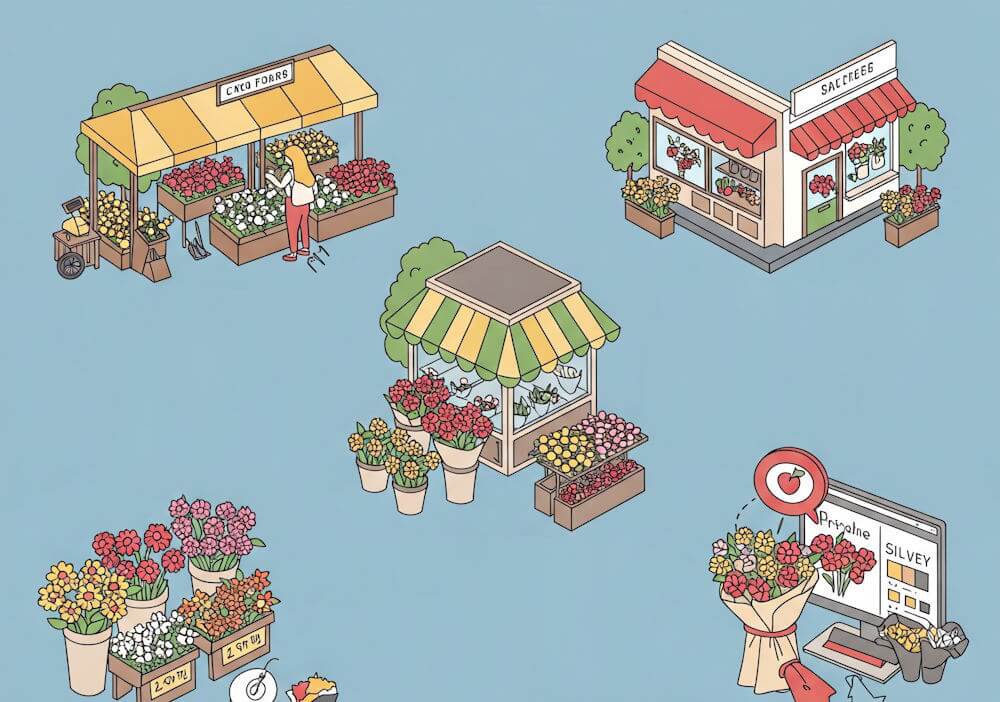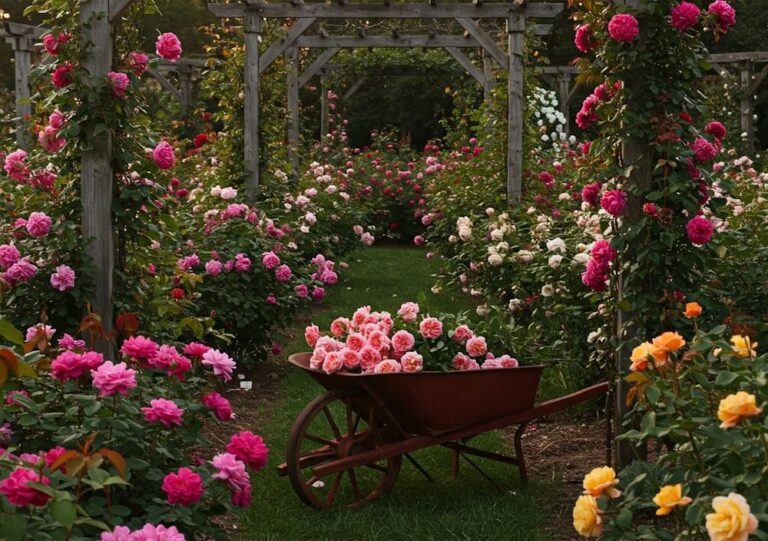Introduction to Selling Cut Flowers
Selling cut flowers can be a fulfilling endeavor, whether you are a seasoned florist or a hobbyist looking to turn a passion into profit. As the demand for fresh flowers remains steadfast across various settings, it is essential to understand the multiple avenues available for entering this market. Different channels cater to diverse customer preferences, and thus, identifying your target market is crucial for success.
One of the most traditional routes for selling cut flowers is through local florists. Partnering with these businesses can offer a reliable avenue for sales. Florists typically have established customer bases and can provide valuable insights about consumer preferences. However, the downside may include sharing profits and potential challenges in maintaining a steady supply or meeting specific floral design standards.
Farmers’ markets represent another traditional selling approach. Participating in these community events allows flower sellers to connect directly with consumers, providing an opportunity to showcase the uniqueness of their blooms. The face-to-face interaction can foster customer loyalty and enable sellers to gather immediate feedback. On the other hand, market stalls often require vendors to invest time in setup and maintenance and may restrict hours of operation based on market schedules.
With advancements in technology, online platforms have emerged as increasingly popular selling channels. Websites and social media offer an expansive reach, allowing sellers to tap into broader audiences and cater to niche markets. Moreover, e-commerce enables sellers to operate outside of traditional business hours. However, this approach presents its own challenges, such as shipping logistics, competition from established retailers, and the need for digital marketing skills to drive traffic to online stores.
In summary, understanding the advantages and disadvantages of each channel in selling cut flowers will enable aspiring vendors to make informed choices when deciding how to enter the floral marketplace. This understanding will set the foundation for exploring both traditional and modern sales strategies effectively.
Local Farmers’ Markets
Selling cut flowers at local farmers’ markets offers a unique opportunity for growers to connect directly with their communities. These venues not only enhance visibility but also foster relationships with customers who appreciate locally sourced products. The community-oriented nature of farmers’ markets enables flower sellers to create a loyal customer base, which can be beneficial for future sales. Furthermore, these markets often provide the advantage of immediate cash flow, allowing sellers to gain financial returns promptly after their sales.
To successfully participate in a farmers’ market, several preparation steps should be taken into consideration. Firstly, understanding local regulations regarding flower sales is crucial. Each market may have specific requirements for vendors, including necessary permits, insurance, and health regulations. It is essential to familiarize oneself with these stipulations before setting up a booth.
When setting up a booth at a farmers’ market, presentation is key. Using attractive displays can draw in customers and showcase the beauty of cut flowers. Crafting arrangements that highlight seasonal blooms can attract more visitors, leading to higher sales. Additionally, considering the layout of the booth is important; an open and inviting setup encourages passersby to stop and browse.
In terms of marketing strategies, it is beneficial to approach potential customers with knowledge and enthusiasm about the flowers being sold. Engaging with customers and sharing information about growing techniques, bloom care, and arrangement tips can create a more enriching shopping experience. This connection may lead to repeat business as consumers appreciate the personalized touch. Overall, local farmers’ markets serve as a viable and lucrative avenue for selling cut flowers, providing accessibility to customers and a vibrant setting for flower growers.
Collaborating with Florists
Forming partnerships with local florists can be a strategic move for flower growers seeking to enhance their market reach and establish reliable supply channels. Given that florists are often the direct link between flower producers and consumers, fostering strong relationships with them can significantly increase a grower’s visibility and sales. To initiate collaboration, flower growers should start by conducting thorough research to identify florists that align with their brand values and target market. Visiting local shops and engaging in conversation can provide insights into the florist’s style, clientele, and supply needs. This initial contact is crucial for building trust and demonstrating a genuine interest in a long-term partnership.
Once a florist has been identified as a potential partner, it is essential to establish a dependable supply chain. Growers must ensure that they can consistently deliver quality flowers that meet the florist’s specifications. Open communication regarding the types of flowers, seasonal availability, and anticipated yields will help florists plan their inventory effectively. Furthermore, growers should be prepared to work closely with florists to understand their delivery and timing requirements, minimizing disruptions in the supply chain.
Negotiating pricing and delivery logistics is a critical component of the collaboration. Flower growers should approach these discussions armed with data on market prices and their own production costs to ensure that both parties benefit from the arrangement. Flexibility in pricing may be necessary, especially for bulk orders or long-term agreements. Additionally, establishing clear expectations concerning delivery schedules and methods will facilitate a smoother partnership.
Ultimately, a collaborative relationship with florists can lead to enhanced market presence and profitability for flower growers. Such partnerships not only provide reliable access to a steady customer base but also foster creativity and innovation in floral arrangements, benefiting both parties involved.
Online Sales Platforms
The trend of selling cut flowers online has gained remarkable traction in recent years, driven by the convenience of e-commerce and changing consumer behaviors. Various online platforms provide producers with the opportunity to reach customers well beyond their local market, thus widening their audience and potential sales. Popular e-commerce sites, such as Etsy, Amazon, and specialized floral marketplaces like Bloom & Wild, enable sellers to create an online storefront that caters to a diverse clientele. Additionally, many flower vendors are harnessing the power of social media channels like Instagram and Facebook, utilizing engaging content to showcase their floral arrangements and engage with consumers directly.
One of the significant advantages of selling cut flowers online is the expanded market reach. Florists and flower growers can cater to customers not only in their immediate vicinity but also nationally and internationally. This wider distribution can lead to increased sales and a broader brand recognition. However, competition in the online flower market can be fierce, as numerous sellers vie for consumer attention. Establishing a strong online presence, coupled with high-quality products, is crucial for standing out in this crowded space.
Logistics is another essential factor to consider when selling cut flowers online. Packaging must ensure that blooms arrive fresh and intact, which often requires investment in appropriate materials. Moreover, shipping costs and delivery timelines can significantly impact the overall customer experience. Excellent customer service is equally vital to address inquiries or issues that may arise during the transaction process. In summary, online sales platforms present flower sellers with numerous benefits, including greater exposure, but also bring challenges such as competition and logistical considerations that must be effectively managed.
Building Your Own Website
In today’s digital age, having a dedicated online presence is crucial for anyone looking to sell cut flowers. A well-designed website serves as a virtual storefront, allowing you to reach a broader audience while showcasing your products effectively. To create a user-friendly website, several essential elements should be considered.
Firstly, the design of your website plays a pivotal role in attracting and retaining visitors. A clean and visually appealing layout, paired with high-quality images of your cut flowers, can enhance the user experience. Utilize colors and fonts that reflect the essence of your floral brand, ensuring that the navigation is intuitive and straightforward. It is vital to organize your product categories effectively, allowing customers to find their desired flowers effortlessly.
Search Engine Optimization (SEO) is another critical factor to consider when building your website. By optimizing your content with relevant keywords related to cut flowers, you can improve your site’s visibility on search engines. Focus on incorporating meta tags, alt text for images, and keyword-rich descriptions to enhance the likelihood of attracting organic traffic. Additionally, maintaining a blog with tips on flower arrangements or care can also bolster SEO and engage potential customers.
Payment processing must be seamless and secure, as ensuring customer trust is paramount. Implementing reliable payment gateways enhances the shopping experience, allowing customers to pay with their preferred methods without hesitation. Additionally, consider offering various shipping options, providing transparent information about delivery times and costs to further encourage sales.
Finally, marketing your website effectively is essential for attracting customers. Utilize social media platforms, email marketing, and even local partnerships to drive traffic to your online store. Engaging with your audience through online promotions or showcasing customer testimonials can build trust and encourage repeat purchases. By focusing on these elements, you can establish a robust online presence that effectively supports your cut flower business.
Seasonal Strategies for Selling Cut Flowers
Capitalizing on seasonal events and holidays presents an excellent opportunity for selling cut flowers. Events such as Valentine’s Day, Mother’s Day, and weddings create a significant demand for floral arrangements. By strategically planning your offerings ahead of these occasions, you can maximize sales and customer satisfaction.
For Valentine’s Day, consider crafting arrangements that emphasize romantic themes. Utilize classic red roses, which are synonymous with love, but also include unique seasonal flowers to create distinctive bouquets. Marketing these arrangements with targeted promotions on social media and local advertisements can drive traffic to your sales points. Customers often appreciate the option of personalized messages with their floral gifts, which adds a thoughtful touch and enhances the overall appeal of your products.
Mother’s Day is another pivotal occasion where the demand for cut flowers surges. Consider designing arrangements that cater to different maternal figures, including grandmothers, aunts, and female mentors. Offering a variety of options, from understated blooms to extravagant bouquets, can attract a broader customer base. Special promotions such as “buy one, get one half off” or discounted delivery services can also incentivize purchases.
Weddings constitute another lucrative market for cut flowers. By collaborating with wedding planners or directly with couples, you could offer bespoke floral services tailored to their themes and preferences. Creating sample arrangements for bridal shows can showcase your skills and attract potential clients. Additionally, being involved in local festivals provides exposure to a wider audience; setting up a booth to sell seasonal flowers not only increases visibility but also allows for immediate customer interaction.
In conclusion, leveraging seasonal and event-driven sales can create substantial opportunities for your cut flower business. Through thoughtful marketing and tailored arrangements, you can effectively meet the needs of your customers while elevating your brand’s presence in the market.
Wholesale Opportunities
Engaging in the wholesale flower market opens avenues for selling cut flowers to larger retailers, event planners, and florists who require significant quantities of blooms. To successfully tap into this segment, it is essential to understand how to approach wholesale buyers effectively. Research potential clients within your locality, such as supermarkets or event organizers, and tailor your offerings to meet their needs. Building relationships with these buyers through networking and personal interactions can increase your chances of securing contracts.
When presenting your flower varieties, ensure that you highlight their quality, freshness, and uniqueness. It can be beneficial to create sample arrangements or displays showcasing your flowers’ versatility and aesthetic appeal. Providing thorough information about your production practices, such as organic cultivation methods or sustainable sourcing, can also attract wholesale buyers who prioritize ethical procurement. Additionally, maintaining a diverse portfolio of flower types and colors may help meet the varying demands of different clients.
Negotiating contracts in the wholesale market requires a clear understanding of pricing strategies and the cost of production. Be prepared to discuss volume discounts and payment terms that are favorable to both parties. Cultivating a good rapport with clients can lead to repeat business and reliable partnerships. Also, effective inventory management is crucial when dealing with wholesale sales, ensuring that the supply meets the demand without excessive overstock. Implementing a systematic approach to track production cycles, sales trends, and order fulfillment will help streamline your wholesale operations.
In conclusion, entering the wholesale flower market requires strategic engagement with buyers, effective presentations of your products, and clear negotiations. By managing your inventory and production effectively, you can create lasting partnerships, driving success in the wholesale cut flower business.
Participating in Flower Shows and Exhibitions
Participating in flower shows and exhibitions represents a valuable marketing opportunity for those engaged in the cut flower industry. These events not only provide a platform to showcase unique flower arrangements but also enable vendors to gain significant visibility, which is essential for building brand recognition among potential buyers. In preparation for these events, it is crucial to have a well-defined strategy that encompasses a range of vital elements.
To begin with, meticulous planning is essential. Vendors should research upcoming flower shows and select those that align with their target market and product offerings. Factors such as location, audience demographic, and theme of the exhibition should inform this decision. Once a suitable event is identified, vendors can focus on curating an impressive selection of flowers, emphasizing unique varieties or arrangements that reflect their brand identity. Attention to detail in presentation—such as using aesthetically pleasing displays—can attract visitors and leave a lasting impression.
Another important aspect of participating in flower shows is networking. Exhibitions provide an ideal setting to connect with fellow florists, potential buyers, suppliers, and industry professionals. Establishing relationships within this network can lead to collaborative opportunities, referrals, and valuable insights into market trends. Engaging with attendees through informative demonstrations or interactive workshops can enhance visibility and showcase floral expertise, further drawing in potential customers.
Additionally, vendors should utilize social media and traditional marketing methods to promote their participation in these events prior to their commencement. This can heighten anticipation among local flower enthusiasts while extending the reach of their brand. Leveraging the exposure gained from flower shows and exhibitions can ultimately catalyze sales growth and establish a strong market presence.
Conclusion and Future Trends
As we conclude our exploration of various avenues for selling cut flowers, it is essential to recap the main options available to florists and flower enthusiasts alike. Marketplaces, local florists, and online platforms each present unique opportunities for selling cut flowers. The decision of where to sell should align with both the product’s attributes and the specific goals of your floral business. By understanding the nuances of each method, sellers can strategically position themselves to maximize sales and customer engagement.
Looking ahead, several trends are emerging within the cut flower market that could significantly shape selling strategies. One major trend is the increasing focus on sustainability. As consumers become more environmentally conscious, there is a growing demand for sustainably sourced cut flowers. Sellers who can showcase eco-friendly practices, such as using organic farming methods or biodegradable packaging, stand to attract a niche market willing to pay a premium for such offerings.
Another trend is the rise of local sourcing. More customers are favoring locally grown flowers over imported varieties, driven by a desire to support their community and reduce the environmental impact associated with long-distance transportation. This shift provides an opportunity for sellers to create direct relationships with local growers, promoting the idea of ‘farm-to-table’ in the floral industry.
Lastly, digital marketing continues to reshape how cut flowers are sold. The increasing reliance on e-commerce has made it essential for sellers to develop an online presence. Utilizing social media platforms to showcase arrangements, share customer testimonials, and promote special offers can lead to enhanced visibility and customer loyalty. As the market evolves, it is vital for sellers to remain adaptable and exploratory, evaluating which selling methods resonate best with their business objectives and the preferences of their target audience.





